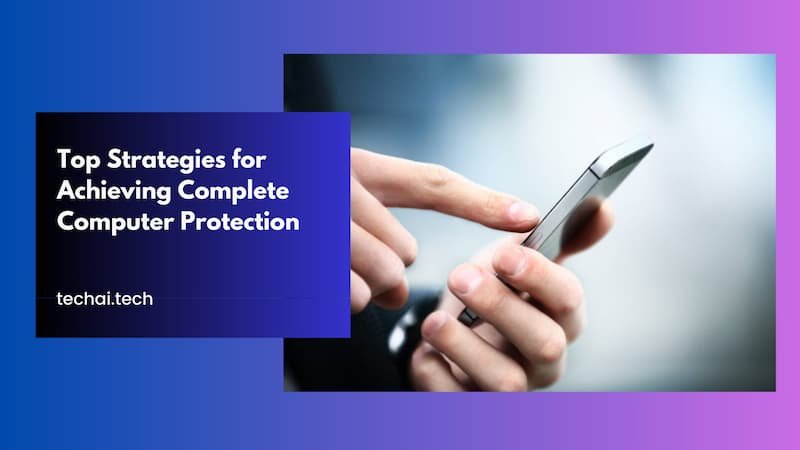Your computer should be protected from malicious software and other threats, which can significantly harm your system in this digital age. Amid the growing number of cyberattacks, malware, and data breaches, ensuring complete computer protection is one of our most significant human concerns. A genuinely secure computer has tools, techniques, and habits that work together to keep your data safe from harm. The following are the best practices for complete computer protection, and this guide will provide these strategies so that you can adequately protect your digital world.
Understanding Complete Computer Protection
What is complete computer protection? It means dodging viruses and malware, avoiding phishing scam websites, and securing your data and privacy. A team of skilled professionals is required to secure a point in time and have multiple rotating changes covering the most decadent possible attack surface, which is everything connected online.
1. Install and Update Your Antivirus Software
The stepping stone to accomplish full-proof security from computer viruses is with an antivirus application. A computer application intended to prevent, identify, and remove malware is called antivirus software (AV), commonly referred to as anti-malware software. These applications keep running in the background, waiting for malicious or unauthorized activities on your system, and instantly alert you of them.
2. Firewall for Network Security
The firewall is a component in your network that keeps security threats under control within it and between you on the Internet, managing who can enter it and any outgoing information leaving through that barrier. In the case of complete computer protection, this represents a firewall since you need access to your computer, preventing intruders and protecting it from attacks by hackers.
3. Update Software and OS
Another essential facet of overall computer protection is updating your operating system and software regularly. Today, software developers release updates regularly to cover security holes or bugs and optimize performance. If you do not install these updates, your computer will be unprotected against potential threats.
The best way to ensure that you always run on the latest version is to use automatic updates provided by most operating systems and software programs. This automatic update feature is a must, as it helps ensure 100% computer protection.
4. Create Strong and Distinct Passwords
Passwords are your PC and online accounts’ first line of protection. An essential aspect of computer security is to have strong, unique passwords for all your accounts. A good password would contain upper- and lower-case letters, numbers, etc. Do not go for common words, your name, or your birthdate.
5. Activate Two-Factor Authentication
Enabling two-factor authentication (2FA), which gives your online accounts an additional layer of security, is the next stage in the process. something you possess, such as a smartphone. Even if someone were to obtain your passwords, 2FA will greatly increase the difficulty for them to access your accounts, thereby offering total computer security.
2FA is an optional security feature that may be found on many different websites and software applications. For more exhaustive computer protection, activate 2FA on all your eligible accounts so that no sensitive account is left behind.
6. Regularly Back Up Your Data
Data loss can occur for several reasons, such as hardware failure or accidental deletion, as well as cyber-attacks such as ransomware. Backing up your data regularly is an important part of complete computer protection. Making backups ensures that all your important files are safe and can be restored in the event of a system crash or security breach.
7. Be Cautious of Phishing Scams
A phishing scam is a deceptive way to fraudulently acquire sensitive information, such as usernames, passwords, or credit card details, by disguising it as an email from someone trustworthy. These scams are typically emails in which attackers get users to click on the wrong links or give away personal information. However, to protect your computer as much as possible, you must avoid all phishing attacks.
Before opening files or clicking links in emails, be sure they are legitimate. Generic greetings, misspellings, or suspicious email addresses are usually good indicators of phishing communication. Also, please familiarize yourself with some standard phishing plans and learn how to avoid them. Thus, while you navigate this virtual ecology of internet interactions back and forth, keep an eye out and use caution.
8. Secure Your Wi-Fi Network
Your computer and other linked devices can be accessed over your Wi-Fi network. Hackers may be able to access your personal information over your network if it is not secure. For total computer security, you must secure your Wi-Fi network.
9. Avoid Public Wi-Fi for Sensitive Transactions
Although handy, public Wi-Fi networks, including coffee shops and airports, need more security. Your data may be compromised if you use public Wi-Fi for sensitive online shopping or banking activities. If you want total PC safety, refrain from public Wi-Fi for anything involving sensitive data.
10. Practice Safe Browsing Habits
You are the most outstanding player in protecting your computer from complete protection and browsing habits. Here, you must know which websites you visit and the files you download. With this, your machine can be protected from some malware incidents.
Go to only secure websites. Never click on pop-up ads or download files from untrustworthy sites. Use a secure browser with these features built-in.
Conclusion
Combining tactics to counter all possible attacks is necessary to achieve total computer protection. Every action you take, including setting up a firewall and antivirus software, observing safe surfing practices, and fortifying your Wi-Fi network, helps create a more secure computer environment.
These methods allow you to lower the risk of hacking and prevent damage to your online integrity. Keep in mind that security updates are ongoing, and your commitment to best practices and constant vigilance can contribute to achieving complete computer protection.

